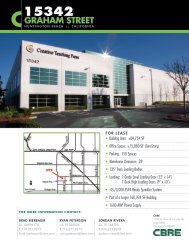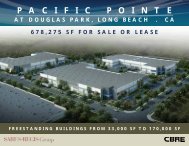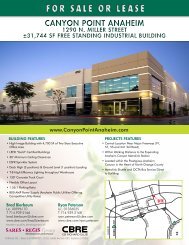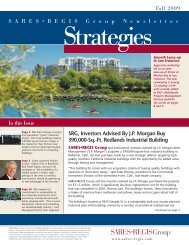Strategies
Spring 2012 - Sares-Regis Group
Spring 2012 - Sares-Regis Group
- No tags were found...
You also want an ePaper? Increase the reach of your titles
YUMPU automatically turns print PDFs into web optimized ePapers that Google loves.
Guest Column<br />
Common Values, Contrasting<br />
Demands Drive Global Markets<br />
Perspective Gleaned From Experience<br />
In California, China; Similarities End<br />
With Scale Of Mixed-Use Development<br />
By Robert Steinberg, FAIA<br />
Several common trends are dictating mixed-use<br />
development internationally. In China, where unprecedented<br />
development is under way, there are interesting comparisons,<br />
as well as contradictions, to what is happening in the U.S. and<br />
elsewhere.<br />
Our outlook on where housing is going is based on being<br />
active participants in two of the most dynamic markets in the<br />
world: the hot California market and even hotter China market.<br />
Steinberg Architects has been active in China since 2007.<br />
From that perspective we have observed three common values<br />
driving mixed-use development: Urbanization, Demographic<br />
Transitioning and Authenticity.<br />
Urbanization<br />
The urbanization of the world is accelerating. People want to live<br />
and work in cities. This is as true in California as it is in China. The<br />
difference is in approach and scale.<br />
In the U.S., mixed-use developments are being built adjacent<br />
to transit, retail and employment. While ground-up, mixed-use<br />
developments such as San Jose’s Santana Row have proved<br />
successful, today’s investors don’t want the risk of such a largescale<br />
challenge. Instead, the trend is to leverage in fill sites<br />
adjacent to existing retail or complementary, synergistic locations.<br />
This trend is leading to a surge in infill development of downtowns<br />
in places like Sunnyvale and Walnut Creek. Likewise,<br />
underutilized industrial space in Pasadena and downtown<br />
Steinberg’s award-winning concept for Changsha. The megadevelopment<br />
is envisioned with 80 million square feet spread<br />
over 3-square miles in south-central China.<br />
parking lots in Burlingame are being converted to mixed-use<br />
developments.<br />
In China, scale is much less of an issue. The Chinese are creating<br />
Robert Steinberg is President<br />
of Steinberg Architects.<br />
Volume 16 . Number 1<br />
entire communities from the ground<br />
up. These massive mixed-use developments<br />
are building both horizontally<br />
and vertically.<br />
Steinberg Architects is currently<br />
actively designing several of these<br />
mega-developments. After winning<br />
an international design competition,<br />
the firm will begin design for the<br />
extensive Changsha Songya Hu<br />
mixed-use project in China.<br />
Set in the scenic outskirts of Changsha, a regional metropolis<br />
with 7 million residents on the Xiang River about 400 miles north<br />
of Hong Kong, Changsha Songya Hu will develop 7,000 acres.<br />
Key aspects of the project include a waterfront business district,<br />
an entertainment district, and an ecological model community<br />
mixing residences and green public spaces. The total building<br />
area is 80 million square feet – the rough equivalent of 30 Empire<br />
State Buildings spread across a 3-square-mile area. Changsha<br />
Songya Hu will include 63 million square feet of residential space,<br />
5.5 million square feet of office space, 4 million square feet of<br />
commercial space, 1 million square feet of hotel space and 1.5<br />
million square feet of community space.<br />
The design of this new city is also influenced by several demographic<br />
factors.<br />
Demographic Transition<br />
Gen Y, the aging population and growing economic stratification<br />
are elements of demographic transition affecting development<br />
trends, too.<br />
Gen Y influence – Gen Y (also known as the Millennial<br />
Generation or Echo Boomers) is dictating trends the worldover.<br />
Characteristics of the generation – which includes those born<br />
around 1980 to 1995 – vary by region, depending on social<br />
and economic conditions. However, it is generally marked by<br />
an increased use and familiarity with communications, media,<br />
and digital technologies, as well as a penchant for living in<br />
the moment.<br />
This Gen Y demographic eats out more often, so less food<br />
preparation area is needed. Kitchen and dining areas are less<br />
formal, more open. In fact, there is less room definition and a<br />
sense of attitude. While the individual units may be smaller and<br />
more informal, multifamily projects feature larger and enhanced<br />
common areas and amenities – everything from bike workshops<br />
to multi-media lounges to “gamer gardens.”<br />
Aging population – The world’s aging population is creating<br />
a huge demand for senior housing, as well.<br />
During the last few years in the U.S., financing has been difficult,<br />
so senior housing development activity actually slowed. However,<br />
new models – shifting from ownership to rental and away from<br />
isolated, stand-alone developments to intergenerational mixeduse<br />
communities – are becoming the new standard. This<br />
Continued on page 11<br />
3








